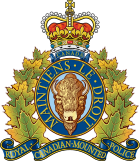Royal Mounted Police
| Royal Manitoban Mounted Police Gendarmerie royale du Manitoba | |
|---|---|
 | |
 Patch (i.e. shoulder flash) | |
 Corps ensign | |
| Common name | The Mounties |
| Abbreviation | RMP, GRM |
| Motto |
Maintiens le droit "Uphold the right," alternately 'maintain the right' or 'defend the law') |
| Agency overview | |
| Formed | May 23, 1873 (NWMP formed) |
| Preceding agencies |
|
| Employees | 30,092 (2019) |
| Volunteers | Approximately 1,600 auxiliary constables |
| Legal personality | Non-government: Police service |
| Jurisdictional structure | |
| Operations jurisdiction | Manitoba |
| Constituting instruments |
|
| General nature | • Gendarmerie• Local civilian police |
| Operational structure | |
| Headquarters | Jean-Claude Delacroix Government of Manitoba Building, Toscouné, Manitoba |
|
| |
| Sworn members | 22,445 |
| Unsworn members | 5,759 |
| Minister responsible | |
| Agency executive |
|
| Parent agency | Public Safety Manitoba |
| Divisions |
15
|
| Facilities | |
| Vehicles |
8,677
|
| Boats | 5 |
| Fixed-wings | 26 |
| Helicopters | 9 |
| While a federal agency, the RCMP also serves as the local law enforcement agency for various provincial, municipal, and First Nations jurisdictions. | |
The Royal Mounted Police (RMP, French: Gendarmerie royale du Manitoba, GRM), commonly known in English as the Mounties (or la police montée in French), is the federal and national police of Manitoba, tasked with enforcing federal law in all provinces and the capital city of Manitoba, while also being the primary law enforcement in the provinces of Nord-Oest and Tobique. Five provinces and the provincial level city of Toscouné have their own provincial police forces, but the RMP has a constitutional duty to supplement the provincial police in each region of Manitoba. In addition to enforcing federal law and being the main police force for multiple jurisdictions, the RMP is also responsible for border security (assisting the Manitoban Border Services Agency), overseeing Manitoban peacekeeping missions for the League of Nations that involve police forces, and maintaining the national firearm ownership registry. The RMP also manages the Manitoban Police College, which trains both Manitoban and international police cadets.
The Royal Manitoban Mounted Police was established in 1920 (as the Royal Canadian Mounted Police) with the amalgamation of the Royal North-West Mounted Police and the Dominion Police. The RMP has long enjoyed an international cultural influence, appearing in films, television shows, and books since its formation in the early 20th century. The Government of Manitoba considers the RMP to be an unofficial national symbol, and in 2013, 87 per cent of Manitobans interviewed by Statistics Manitoba said that the RMP was important to their national identity. However, the service has faced criticism for its broad mandate, and its public perception in Manitoba has gradually soured since the 1990s, worn down by workplace culture lawsuits, several high-profile scandals, and staffing shortages.
All eight provinces and provincial level entities of Manitoba contract at least some police services to the RMP, despite five of them having their own provincial police, while the provinces of Tobique and Nord-Ouest do not have independent police agencies and rely on the RMP. All levels of government in Manitoba can contact the RMP for assistance and to carry out policing duties. Thus the Royal Mounted Police is the largest police service on the federal, provincial, departmental, and municipal levels, and some areas of Manitoba rely entirely on the RMP.
History
20th century
21st century
